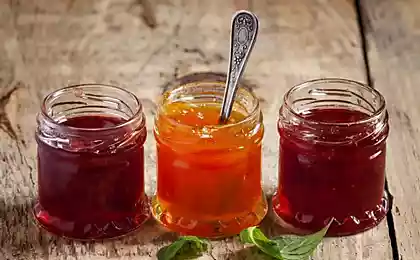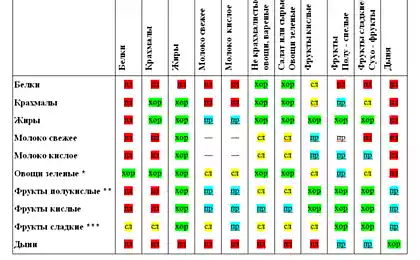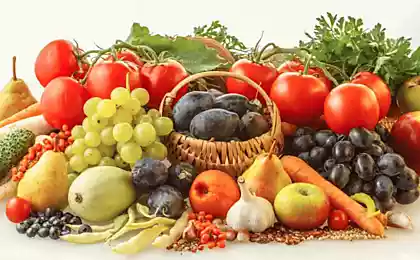1244
12 of the most exotic fruits and vegetables
1. Purple morkov
Several generations of people are convinced that there is only carrots orange, but purple - the original, original color of this vegetable. The color is caused by beta carotene carrots with some addition of alpha carotene pigment. They include purple anthocyanin pigments, which acts as an antioxidant.
The purple carrot is shown in the figures, made in Egyptian temple even 2000 years BC. In the tenth century, purple carrot grown in Afghanistan, Pakistan, northern Iran. In the fourteenth century in southern Europe were imported crimson, white and yellow varieties. To grow as black, red and green carrots.
Recently, the Dutch growers have learned the useful properties of purple carrots. They believe that the purple vegetable provides the body with additional protection against cancer and cardiovascular disease.
2. Black pomidory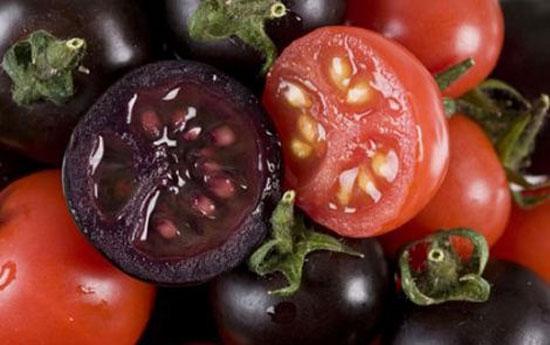
A unique variety of tomato went on sale in the UK market. According to some experts, vegetable contains a substance many times enhances sexual desire. A new variety of black tomatoes called "Kumata." This relative of the wild plant Lycopersicon cheesmanii. The size of it is the same as conventional tomatoes, but sweeter and peel his brown-black color. It took six years of research to improve the vegetable and start selling it in Europe. When the first tomatoes were grown by the Aztecs and Incas in the VIII century, they were not only red, but yellow, green, red, white and black. They are grown in what is now located Ecuador, Bolivia, Chile, Peru and Mexico.
This hybrid tomato with blackberry able to extend the life of 30% of the mice that are prone to colon cancer. Besides the advantages that ordinary tomatoes - high levels of vitamin C and antioxidants.
3. Rainbow kapusta
"Rainbow" cauliflower appeared in England. Syngeta British company has launched a new variety of cauliflower - Rainbow Cauliflowers, inflorescences which are painted in bright orange, green and purple. The taste is exactly the same cabbage, but it adds color to the cooked meals - a new variety does not lose its saturated color even after cooking.
Another advantage of the cauliflower-world that in orange variety contained 25 times more beta-carotene than normal inflorescences, and saturated purple anthocyanin, which is useful for preventing heart disease, blood clotting because slows.
The representative of the company, Andrew Coker said that the unusual color of the cabbage - is not a product of genetic engineering, as a result of traditional breeding, which took more than a decade.
4. Strawberry paynberri
Homeland of the fetus, which has the same genetic structure as usual strawberries, but the taste and smell like pineapple, considered South America. There he was discovered by Dutch farmers and for seven years, successfully cultivated in greenhouses. Unique species is critically endangered when Dutch farmers have revived it in greenhouses. The unripe green berries form and on their ripeness say white skins and seeds of red.
5. Purple kartofel
In the UK, the market entered a new variety of potato, saturated purple. Purple also are all derivatives of this vegetable - potato chips, mashed potatoes, and so on. D. Potatoes, called Purple Majesty, the taste is the same as its more familiar to us relatives, but rich in anthocyanins - they give blueberries, blackberries and aubergines their distinctive colors.
A new variety is grown in Scotland. This year has been collected about 400 tons of the crop, which is not very much, but the following year manufacturers plan to increase the figure.
Blue potatoes are divided into several types. For example, grade Franzosische Truffel-kartoffel and Linzer Blaue in the cooking process does not lose its color is dark blue and is very boiled soft. While the other two Linzer Roze and Kipfler long enough prepared and not boiled soft, but the cooking process loses its unusual color. They are usually used in crude form from Jerusalem artichoke in salads.
6. Red ogurtsy
These vegetables are only conditionally called "red cucumber." In fact the classical cucumbers they have nothing in common. They do not have a taste and are used more for decorative purposes.
This vegetable in appearance very similar to a cucumber, even though it has the color of bright red. But it tastes just "no." In fact, this fruit belongs to the family Cucurbitaceae plants and is called "Red cucumber" or "Thladiantha Dubia." This miracle was brought to Europe from Southeast Asia, and is considered a great decorative plants than edible. However, if you put this beauty in their country, then a couple of years, your entire garden will be a continuous thickets of red cucumber.
7. Romanescu
It is a close relative of broccoli and cauliflower. If you like cabbage, this vegetable is fantastic you will surely enjoy. In addition, this wonderful vegetable, packed with antioxidants.
Romanescu or Romanesque broccoli, cauliflower coral sprouts. Designers and 3D-artists admire its exotic forms similar to fractals. Buds Brassica growing logarithmic spiral. The first mention of cabbage Romanescu came from Italy of the 16th century.
Romanesque broccoli has the naitonchashim taste, how can have cabbage. Romanescu not crumbly, tasty broccoli, sweetish nutty, and not a hint of sulfur taste. Fresh cabbage Romanescu should be stored in the refrigerator for 4 days. Since cabbage is solid, head gear is cut into pieces with a knife.
With pieces of cabbage Romanescu prepared casserole, served with bechamel sauce and blue cheese. Cabbage is rich in antioxidants Romanescu carotenoids, vitamin C
This exotic vegetables are easy to grow for those who have experience in growing broccoli, because agricultural machinery is identical.
8. nods Melon (Cucumis metuliferus) 38,662,818
Melon nods (Antilles cucumber, horned melon, Angoor). Kiva, Kiwi countryman, a native of Nova Zealand. Externally the fruit resembles a yellow-orange cucumber with multiple horns. In fact it nods not so terrible as it seems: the spines are soft, leaky crust. The best way of eating fruit - cut it in half and vyhlebat green pulp. Nods like a cucumber and lemon at the same time - refreshing. It contains vitamins PP, and vitamin C in it more than enough.
The average fruit weight 300 grams, the average length of 12 cm. The fruits are extremely decorative and can be used to create original compositions and even as Christmas decorations.
9. Hand Buddy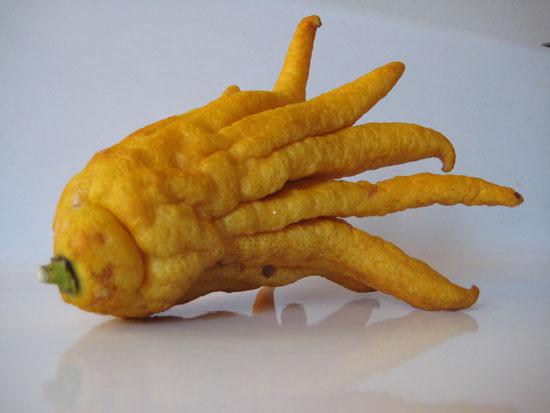
It is popular in Asia, the fruit of one of the members of the subfamily citrus (Rutaceae family). The content of the fruit under the thick skin very much like a lemon. It has the largest of all citrus fruits. Their length is 20-40 cm. Diameter - 14-28 cm.
10. Durio
The fruit durian recalls some "alien" fruit the size of a soccer ball, covered with barbed tough skin. The pulp of the fruit inside a pale yellow color. It smells like a dirty worn socks, rotting meat, or sewage (choose what you like). Nevertheless, the fruit taste is amazing and elegant. The first European explorer who in the 1700s first tried this fruit called him "the king of fruits." "As soon go on a dangerous journey only in order to try this fruit," - said the brave traveler.
11. Monstera (Monstera deliciosa) 47,220,823
Monstera is growing in many homes. In nature, this plant produces delicious fruit. Mature fruits of monstera core, despite the unpleasant pungent smell, the taste is reminiscent of pineapple.
12. Star frukt
Cross section of the fruit forms a substantially correct star. This fruit is juicy, sweet with a hint of sour. Tastes like grapes, mango, lemon - all in one. In its composition contains a lot of oxalic acid, so do not abuse this fruit is recommended for people with kidney failure. Homeland of the fruit - Sri Lanka
Source: www.billionnews.ru
via factroom.ru

Several generations of people are convinced that there is only carrots orange, but purple - the original, original color of this vegetable. The color is caused by beta carotene carrots with some addition of alpha carotene pigment. They include purple anthocyanin pigments, which acts as an antioxidant.
The purple carrot is shown in the figures, made in Egyptian temple even 2000 years BC. In the tenth century, purple carrot grown in Afghanistan, Pakistan, northern Iran. In the fourteenth century in southern Europe were imported crimson, white and yellow varieties. To grow as black, red and green carrots.
Recently, the Dutch growers have learned the useful properties of purple carrots. They believe that the purple vegetable provides the body with additional protection against cancer and cardiovascular disease.
2. Black pomidory

A unique variety of tomato went on sale in the UK market. According to some experts, vegetable contains a substance many times enhances sexual desire. A new variety of black tomatoes called "Kumata." This relative of the wild plant Lycopersicon cheesmanii. The size of it is the same as conventional tomatoes, but sweeter and peel his brown-black color. It took six years of research to improve the vegetable and start selling it in Europe. When the first tomatoes were grown by the Aztecs and Incas in the VIII century, they were not only red, but yellow, green, red, white and black. They are grown in what is now located Ecuador, Bolivia, Chile, Peru and Mexico.
This hybrid tomato with blackberry able to extend the life of 30% of the mice that are prone to colon cancer. Besides the advantages that ordinary tomatoes - high levels of vitamin C and antioxidants.
3. Rainbow kapusta

"Rainbow" cauliflower appeared in England. Syngeta British company has launched a new variety of cauliflower - Rainbow Cauliflowers, inflorescences which are painted in bright orange, green and purple. The taste is exactly the same cabbage, but it adds color to the cooked meals - a new variety does not lose its saturated color even after cooking.
Another advantage of the cauliflower-world that in orange variety contained 25 times more beta-carotene than normal inflorescences, and saturated purple anthocyanin, which is useful for preventing heart disease, blood clotting because slows.
The representative of the company, Andrew Coker said that the unusual color of the cabbage - is not a product of genetic engineering, as a result of traditional breeding, which took more than a decade.
4. Strawberry paynberri

Homeland of the fetus, which has the same genetic structure as usual strawberries, but the taste and smell like pineapple, considered South America. There he was discovered by Dutch farmers and for seven years, successfully cultivated in greenhouses. Unique species is critically endangered when Dutch farmers have revived it in greenhouses. The unripe green berries form and on their ripeness say white skins and seeds of red.
5. Purple kartofel

In the UK, the market entered a new variety of potato, saturated purple. Purple also are all derivatives of this vegetable - potato chips, mashed potatoes, and so on. D. Potatoes, called Purple Majesty, the taste is the same as its more familiar to us relatives, but rich in anthocyanins - they give blueberries, blackberries and aubergines their distinctive colors.
A new variety is grown in Scotland. This year has been collected about 400 tons of the crop, which is not very much, but the following year manufacturers plan to increase the figure.
Blue potatoes are divided into several types. For example, grade Franzosische Truffel-kartoffel and Linzer Blaue in the cooking process does not lose its color is dark blue and is very boiled soft. While the other two Linzer Roze and Kipfler long enough prepared and not boiled soft, but the cooking process loses its unusual color. They are usually used in crude form from Jerusalem artichoke in salads.
6. Red ogurtsy

These vegetables are only conditionally called "red cucumber." In fact the classical cucumbers they have nothing in common. They do not have a taste and are used more for decorative purposes.
This vegetable in appearance very similar to a cucumber, even though it has the color of bright red. But it tastes just "no." In fact, this fruit belongs to the family Cucurbitaceae plants and is called "Red cucumber" or "Thladiantha Dubia." This miracle was brought to Europe from Southeast Asia, and is considered a great decorative plants than edible. However, if you put this beauty in their country, then a couple of years, your entire garden will be a continuous thickets of red cucumber.
7. Romanescu

It is a close relative of broccoli and cauliflower. If you like cabbage, this vegetable is fantastic you will surely enjoy. In addition, this wonderful vegetable, packed with antioxidants.
Romanescu or Romanesque broccoli, cauliflower coral sprouts. Designers and 3D-artists admire its exotic forms similar to fractals. Buds Brassica growing logarithmic spiral. The first mention of cabbage Romanescu came from Italy of the 16th century.
Romanesque broccoli has the naitonchashim taste, how can have cabbage. Romanescu not crumbly, tasty broccoli, sweetish nutty, and not a hint of sulfur taste. Fresh cabbage Romanescu should be stored in the refrigerator for 4 days. Since cabbage is solid, head gear is cut into pieces with a knife.
With pieces of cabbage Romanescu prepared casserole, served with bechamel sauce and blue cheese. Cabbage is rich in antioxidants Romanescu carotenoids, vitamin C
This exotic vegetables are easy to grow for those who have experience in growing broccoli, because agricultural machinery is identical.
8. nods Melon (Cucumis metuliferus) 38,662,818
Melon nods (Antilles cucumber, horned melon, Angoor). Kiva, Kiwi countryman, a native of Nova Zealand. Externally the fruit resembles a yellow-orange cucumber with multiple horns. In fact it nods not so terrible as it seems: the spines are soft, leaky crust. The best way of eating fruit - cut it in half and vyhlebat green pulp. Nods like a cucumber and lemon at the same time - refreshing. It contains vitamins PP, and vitamin C in it more than enough.
The average fruit weight 300 grams, the average length of 12 cm. The fruits are extremely decorative and can be used to create original compositions and even as Christmas decorations.
9. Hand Buddy

It is popular in Asia, the fruit of one of the members of the subfamily citrus (Rutaceae family). The content of the fruit under the thick skin very much like a lemon. It has the largest of all citrus fruits. Their length is 20-40 cm. Diameter - 14-28 cm.
10. Durio

The fruit durian recalls some "alien" fruit the size of a soccer ball, covered with barbed tough skin. The pulp of the fruit inside a pale yellow color. It smells like a dirty worn socks, rotting meat, or sewage (choose what you like). Nevertheless, the fruit taste is amazing and elegant. The first European explorer who in the 1700s first tried this fruit called him "the king of fruits." "As soon go on a dangerous journey only in order to try this fruit," - said the brave traveler.
11. Monstera (Monstera deliciosa) 47,220,823
Monstera is growing in many homes. In nature, this plant produces delicious fruit. Mature fruits of monstera core, despite the unpleasant pungent smell, the taste is reminiscent of pineapple.
12. Star frukt

Cross section of the fruit forms a substantially correct star. This fruit is juicy, sweet with a hint of sour. Tastes like grapes, mango, lemon - all in one. In its composition contains a lot of oxalic acid, so do not abuse this fruit is recommended for people with kidney failure. Homeland of the fruit - Sri Lanka
Source: www.billionnews.ru
via factroom.ru







